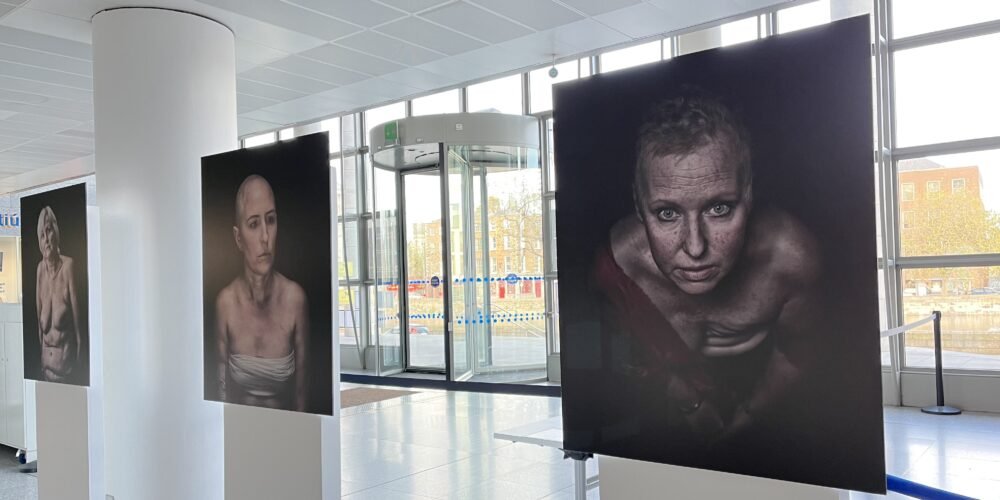‘Seen to be Heard’ reveals secondary breast cancer realities

A crowd of people gathered at Dublin’s City Council office on Monday to welcome in the annual Inclusion and Integration Week. Those in attendance were surrounded by large photographs of women who have felt isolated rather than included due to disease – women diagnosed with secondary breast cancer.
Monday’s occasion kicked off a string of events all week, including a photography exhibit of those battling secondary breast cancer, which is breast cancer that has spread to other parts of the body like the bones or brain. The exhibit began in Northern Ireland as a “promise” between photographer Jennifer Willis and women feeling isolated with the disease.
“It was basically a promise that I made to a group of women who felt invisible and second best within the healthcare system,” Willis told Babylon. “I promised that I would enable their images to be seen so that their voices would be heard.”
This “promise” began in Northern Ireland between Willis and her friend Cheryl Graham after Graham was diagnosed with secondary breast cancer and asked Willis to photograph her until her death. This grew to an exhibition of 32 photographs of 16 women titled, “Seen to be Heard,” which is making its first appearance in the Republic of Ireland.
Graham was among the speakers on Monday, addressing those gathered briefly with a clear message.
“We all have stories of systematic failures, whether in diagnosis, treatment, or inadequate support services,” she said. “We all have experienced a lack of empathy in our care and we all have felt socially isolated, living with a disease that is not widely understood.”
Individuals with the disease not only face a terminal illness but may do so without adequate nursing and support groups, Willis said. There were no support groups for those with secondary breast cancer in Northern Ireland until recently, she said, the same people who are “living from scan to scan.”
The advanced stage of breast cancer kills roughly 750-800 people in Ireland each year, Willis told the crowd, with a little more than a handful of those individuals being men. Secondary breast cancer is the largest killer of women between 35 to 64 years-old, she said.
One-third of the public is unaware of what the advanced form of breast cancer even is, Willis said, as she was, prior to photographing Graham. The undertaking “has taken its toll,” Willis told Babylon, who’s now photographed more than 23 women.
“You can’t do a project like this without getting to know them. And I refer to them as my friends, and we socialise together, but getting to know them is a big part of it,” she said. “So, it sort of might sound cliché, but I do carry a piece of them all in here.”
The connection between Willis and the women portrayed is evident as she begins to list off the names and situations of the women pictured on one side of the room. One woman, at 35 years-old, will never get the chance to have kids, another has young children and another with a 24 year-old son.
Her hope is for visitors to get a better understanding of those living with the illness and connect with affected women who are extremely lonely.
This connection with individuals experiencing secondary breast cancer is also what Graham hopes people experience when they see the photographs.
“We hope that you’re able to connect with our story through Jennifer’s powerful images,” she said. “Look at us, listen to us. Just because we have secondary breast cancer does not mean we are second best.”

Secondary breast cancer – “a woman’s disease”
Joe Moran was among those who stopped by to take in the exhibition on its first day, Tuesday. Moran walked from photo to photo, snapping a photograph of each on his phone. Then one of the images made him pause and bow his head, a picture of a woman unable to hold back her tears.
Secondary breast cancer is personal for Moran, who lost his wife to the disease. When she was tested for breast cancer in the late 1990s she was given the all clear, but about five years later doctors found that she in fact had cancer and it had spread, he told Babylon.
His wife, healthy prior to cancer, repeatedly told Moran that it was a “woman’s disease,” “just a woman’s problem,” to not worry him, he recalled. If the disease affected more men there would be change, Moran said.
“If it was a man’s, mainly, disease you’d see there’d be a complete change, and that’s what annoys me with the whole affair,” he said. “It’s very upsetting.”
Rather than just portray the stories of women who are experiencing what Moran’s wife did, the exhibition is also looking to create concrete changes in the caring for those with secondary breast cancer.
The exhibition has already begun to have an impact, Willis told Babylon. Some Northern Ireland cancer charities have begun to realise the lack of support available for those with secondary breast cancer, she said. There are also plans to do an audit of services for the disease.
The photographs will be displayed to the public through Sunday, with 30 person spots available every 45 minutes. Tickets can be reserved online on the Inclusion and Integration Week webpage.
As one of the women photographed for the ‘Seen to be Heard’ exhibition, I would like to commend this young journalist, he has obviously ‘seen’ us, and ‘listened’ to us. Thank you and well done.